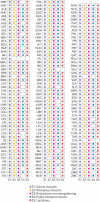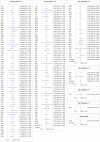Physical distancing interventions and incidence of coronavirus disease 2019: natural experiment in 149 countries
- PMID: 32669358
- PMCID: PMC7360923
- DOI: 10.1136/bmj.m2743
Physical distancing interventions and incidence of coronavirus disease 2019: natural experiment in 149 countries
Abstract
Objective: To evaluate the association between physical distancing interventions and incidence of coronavirus disease 2019 (covid-19) globally.
Design: Natural experiment using interrupted time series analysis, with results synthesised using meta-analysis.
Setting: 149 countries or regions, with data on daily reported cases of covid-19 from the European Centre for Disease Prevention and Control and data on the physical distancing policies from the Oxford covid-19 Government Response Tracker.
Participants: Individual countries or regions that implemented one of the five physical distancing interventions (closures of schools, workplaces, and public transport, restrictions on mass gatherings and public events, and restrictions on movement (lockdowns)) between 1 January and 30 May 2020.
Main outcome measure: Incidence rate ratios (IRRs) of covid-19 before and after implementation of physical distancing interventions, estimated using data to 30 May 2020 or 30 days post-intervention, whichever occurred first. IRRs were synthesised across countries using random effects meta-analysis.
Results: On average, implementation of any physical distancing intervention was associated with an overall reduction in covid-19 incidence of 13% (IRR 0.87, 95% confidence interval 0.85 to 0.89; n=149 countries). Closure of public transport was not associated with any additional reduction in covid-19 incidence when the other four physical distancing interventions were in place (pooled IRR with and without public transport closure was 0.85, 0.82 to 0.88; n=72, and 0.87, 0.84 to 0.91; n=32, respectively). Data from 11 countries also suggested similar overall effectiveness (pooled IRR 0.85, 0.81 to 0.89) when school closures, workplace closures, and restrictions on mass gatherings were in place. In terms of sequence of interventions, earlier implementation of lockdown was associated with a larger reduction in covid-19 incidence (pooled IRR 0.86, 0.84 to 0.89; n=105) compared with a delayed implementation of lockdown after other physical distancing interventions were in place (pooled IRR 0.90, 0.87 to 0.94; n=41).
Conclusions: Physical distancing interventions were associated with reductions in the incidence of covid-19 globally. No evidence was found of an additional effect of public transport closure when the other four physical distancing measures were in place. Earlier implementation of lockdown was associated with a larger reduction in the incidence of covid-19. These findings might support policy decisions as countries prepare to impose or lift physical distancing measures in current or future epidemic waves.
© Author(s) (or their employer(s)) 2019. Re-use permitted under CC BY-NC. No commercial re-use. See rights and permissions. Published by BMJ.
Conflict of interest statement
Competing interests: All authors have completed the ICMJE uniform disclosure form at www.icmje.org/coi_disclosure.pdf and declare: NI receives salary support from the Nuffield Department of Population Health, University of Oxford; no financial relationships with any organisations that might have an interest in the submitted work in the previous three years; no other relationships or activities that could appear to have influenced the submitted work.
Figures




Comment in
-
Lockdown-type measures look effective against covid-19.BMJ. 2020 Jul 15;370:m2809. doi: 10.1136/bmj.m2809. BMJ. 2020. PMID: 32669280 No abstract available.
References
-
- Prem K, Liu Y, Russell TW, et al. Centre for the Mathematical Modelling of Infectious Diseases COVID-19 Working Group The effect of control strategies to reduce social mixing on outcomes of the COVID-19 epidemic in Wuhan, China: a modelling study. Lancet Public Health 2020;5:e261-70. 10.1016/S2468-2667(20)30073-6. - DOI - PMC - PubMed
MeSH terms
Grants and funding
LinkOut - more resources
Full Text Sources
Medical
